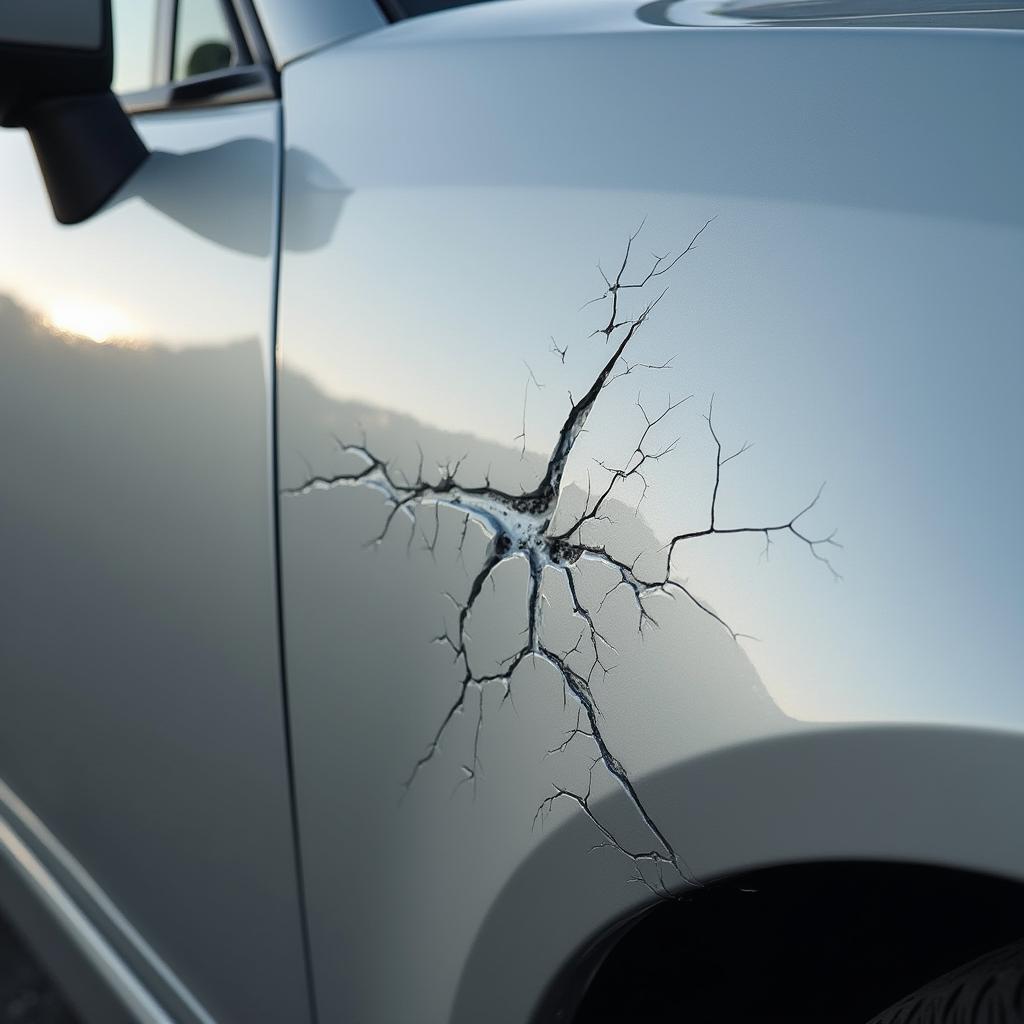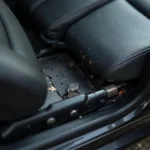Discovering cracks in your car’s paint can be disheartening. Whether it’s due to age, weather damage, or minor accidents, those unsightly lines can detract from your vehicle’s appearance and potentially lead to more serious issues like rust. But don’t despair! This guide will walk you through everything you need to know about repairing paint cracks on your car, from understanding the causes to exploring DIY solutions and professional options.
 Close-up of a car paint crack
Close-up of a car paint crack
Why Does Car Paint Crack?
Before diving into repair solutions, it’s essential to understand the common culprits behind those pesky paint cracks:
- Sun Damage: Prolonged exposure to the sun’s harmful UV rays can cause the paint to fade, become brittle, and eventually crack. This is especially true for cars parked outdoors frequently.
- Temperature Fluctuations: Extreme temperature swings between hot and cold can cause the paint to expand and contract, weakening its structure over time and leading to cracks.
- Improper Washing Techniques: Harsh chemicals, abrasive materials, and even high-pressure washing can strip the paint’s protective layer and make it more susceptible to cracking.
- Minor Accidents and Impacts: Small dents, scratches, and stone chips, if left untreated, can create weak points in the paint, making it more prone to cracking around those areas.
- Poor Quality Paint Job: Using low-quality paint or improper application techniques can result in a weaker paint job that’s more likely to crack prematurely.
DIY Solutions for Minor Paint Cracks
If you’re dealing with minor, hairline cracks, you might be able to tackle them yourself with some readily available products:
- Touch-Up Paint: For small, isolated cracks, touch-up paint that matches your car’s color can be a quick fix. Clean the area thoroughly, apply the paint carefully, and let it dry completely.
- Automotive Primer: If the crack exposes the bare metal, using an automotive primer before applying touch-up paint can help prevent rust and ensure better paint adhesion.
- Rubbing Compound: For superficial cracks or crazing (fine cracks on the surface), a rubbing compound can help minimize their appearance. Apply it with a soft cloth using circular motions and buff it out for a smoother finish.
Remember: DIY solutions are best suited for minor, cosmetic imperfections. For larger or deeper cracks, it’s always recommended to consult with a professional auto body shop to assess the damage and recommend the best course of action.
When to Seek Professional Help
While DIY fixes can be tempting, there are instances where professional intervention is essential:
- Large or Deep Cracks: Extensive cracking or cracks that penetrate through multiple layers of paint require professional expertise and specialized tools for proper repair.
- Rust Formation: If you notice rust forming around or beneath the paint cracks, it’s crucial to address it immediately to prevent further damage.
- Cracks on Body Lines: Repairing cracks on body lines or curved surfaces demands a high level of skill and precision to ensure a seamless finish.
how to repair cracks in car paint
Professional Repair Options for Car Paint Cracks
Professional auto body shops have the experience and tools to effectively repair paint cracks, restoring your car’s appearance and protecting it from further damage. Here are some common repair methods:
- Sanding and Repainting: This involves sanding down the affected area to remove the cracked paint, applying primer, and then repainting the area to match the surrounding finish.
- Spot Repair: For localized cracks, a spot repair might be sufficient. This focuses on repairing and repainting only the damaged area, blending it seamlessly with the existing paint.
- Panel Replacement: In cases of severe cracking or damage to the underlying metal, replacing the entire panel might be necessary to ensure a long-lasting and aesthetically pleasing repair.
mobile car paint repair newbury
Preventing Future Paint Cracks
Prevention is always better than cure. By taking some proactive measures, you can help keep your car’s paint job looking its best and minimize the risk of future cracks:
- Regular Washing and Waxing: Wash your car regularly using a pH-neutral car wash soap and a soft mitt. Apply a coat of wax every few months to protect the paint from UV rays and environmental contaminants.
- Covered Parking: Whenever possible, park your car in a garage or under a carport to shield it from direct sunlight, extreme temperatures, and bird droppings.
- Promptly Address Minor Damage: Repair minor scratches, dents, and chips as soon as possible to prevent them from worsening and potentially leading to cracks.
Conclusion
Repairing paint cracks on your car is essential for preserving its appearance and protecting it from further damage. While minor cracks might be tackled with DIY solutions, seeking professional help is crucial for larger or more complex issues. By understanding the causes of paint cracks and adopting preventive measures, you can help keep your car looking its best for years to come.
Need help with your car’s paint? Contact us today via WhatsApp: +1(641)206-8880 or Email: [email protected]. Our team of experts is available 24/7 to answer your questions and provide professional assistance.


